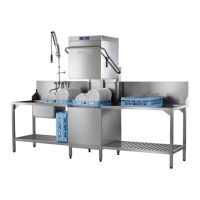How to prevent glass breakages in Hobart AM900?
- SSharon DawsonJul 27, 2025
To prevent glass breakages in your Hobart Dishwasher, make sure you are using appropriate dish or glass racks.

How to prevent glass breakages in Hobart AM900?
To prevent glass breakages in your Hobart Dishwasher, make sure you are using appropriate dish or glass racks.
Why are glasses cloudy after washing in my Hobart AM900?
If glasses are totally or partially cloudy after washing in your Hobart Dishwasher, it could be due to glass corrosion, where the surface of the glasses is rough and porous. This is not caused by a malfunction of the machine, so you should replace the glasses.
Why don't dishes dry properly in my Hobart AM900 Dishwasher?
If dishes or glasses aren't drying properly in your Hobart Dishwasher, the rinse aid concentration might be too low, so increase it. If dishes are still greasy, the detergent concentration might be too low or not appropriate, so increase the concentration or choose a stronger detergent. Also, make sure to drain soiled water and refill the machine, checking the pre-scrapping procedure. Ensure you're using appropriate racks that allow water to drain away from cavities. Finally, take out dishes as soon as the cycle is completed to enable them to dry.
What to do if there are stripes and stains on dishes from Hobart AM900 Dishwasher?
If you notice stripes and stains on dishes or glasses from your Hobart Dishwasher, start by checking the rinse aid concentration; it might be too high, so reduce the quantity. Also, if the rinse aid concentration is insufficient it can cause stains, so increase the quantity. Hard water or high mineral content can also be a factor, so check your water quality with your local water authority. Ideal degree of hardness is 4° Clark. Ideal conductivity value for glasses is max. 150 µS/cm and for dishes max. 400 µS/cm. If you have a machine with a softener, ensure you're using only granular regeneration salt. Lastly, ensure you are using appropriate racks.
Why does my Hobart AM900 stop during the wash program?
If your Hobart Dishwasher suddenly stops during a wash program, it could be due to the machine being connected to a 'maximum power supply unit' that's cutting out, or it's interlocked with another energy consumer unit. In this case, connect the machine separately and call an electrician. Another possibility is a blown site fuse, so check the site fuses.
| Model | AM900 |
|---|---|
| Category | Dishwasher |
| Water Usage per Rack | 0.74 gallons |
| Phase | 3 |
| Motor Horsepower | 1 hp |
| Type | Door Type |
| Voltage | 208-240V |
Machine intended for washing ware like plates, cups, glasses, cutlery, trays.
Key safety instructions, including 'Never hose down the machine.'
Warranty affected by unauthorized technicians, parts, or alterations.
Details on rear wall clearance, corner installation clearance, and leveling.
Adjusting guide rails to suit different operation directions.
Requirements for connection by authorized technician, compliance with codes.
Requirements for connection by authorized technician, water quality, pressure.
Max height and hose placement for drain connection.
Procedures for connecting a detergent dispenser, including tank draining.
Installation guidelines for the conductivity probe.
Functionality of ON/OFF, Program, and Stop buttons for operation.
Shows temperature indications for Wash and Rinse cycles.
Signals for salt requirement and machine faults (Service indicator).
Instructions for using detergent and rinse aid, including type and handling.
Manual procedure for priming detergent and rinse aid suction hoses.
Priming the detergent suction hose using the ON/OFF button.
Priming the rinse aid suction hose using Program and ON/OFF buttons.
How to terminate the hose priming procedure.
Filling the softener with regeneration salt and potable water.
Steps before starting a wash cycle, checking components and supplies.
Loading racks, starting the wash cycle, and unloading.
How to select and change wash programs (P01, P02, P03).
Steps to properly shut down the machine.
Daily cleaning for the machine interior and parts.
Weekly cleaning tasks, including wash and rinse arms.
How to display current wash and rinse temperatures.
Table listing error codes, possible causes, and measures.
Explanation of service indicator and associated faults (FIL, SIE, UL, F01-F04).
Explains moving light point indications, like softener regeneration.
How to adjust detergent dosage time.
How to adjust rinse aid dosage time.
Adjusting the softener based on local water hardness.
Viewing the total number of wash cycles performed.
Viewing the total water consumed by the machine.
Displays remaining capacity of external water treatment.
How to exit setting modes and save changes.
Steps to take for frost prevention during pauses.
Recommendation for a service contract with the local Service Office.
Issues like dishes not clean or not drying properly.
Specific causes and remedies for drying issues.
Stripes, stains, cloudiness, breakages, machine stopping.
Specific issues like cloudy glasses, glass breakages, machine stopping.